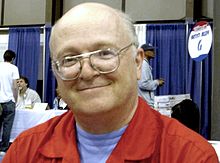Peter Laird
| Peter Laird | |
|---|---|

Peter Laird at the 2008 New York Comic Con.
|
|
| Born |
January 27, 1954 North Adams, Massachusetts |
| Nationality | American |
| Area(s) | Writer, artist, penciler, inker, colorist, letterer, editor |
|
Notable works
|
Teenage Mutant Ninja Turtles |
|
Collaborators
|
Kevin Eastman, Jim Lawson |
Peter Alan Laird (born January 27, 1954) is an American comic book writer and artist. He is best known for co-creating the Teenage Mutant Ninja Turtles with writer and artist Kevin Eastman.
Laird was born on January 27, 1954 in North Adams, Massachusetts. Toward the end of 1983, Laird was earning just ten dollars an illustration from a local newspaper in Northampton, Massachusetts. He was also doing illustrations for fanzines like The Oracle.
In May 1984, Laird and Kevin Eastman self-published the first black & white issue of Teenage Mutant Ninja Turtles, at an initial print run of 3000 copies for the forty-page oversized comic. It was largely funded by a loan from Eastman's uncle, Quentin (the experience of which had a profound impact on Laird, and led indirectly to his later work with the Xeric Foundation), and published by the duo's Mirage Studios, a name chosen because "there wasn’t an actual studio, only kitchen tables and couches with lap boards." That first issue received a number of subsequent printings over the next few years, as the Turtles phenomenon began to take off.
Laird's newspaper experience led to the duo creating "a four-page press kit," that, according to Flaming Carrot-creator Bob Burden's own Mystery Men press-kit included "a story outline and artwork that they sent to 180 TV and radio stations," as well as both the Associated Press and United Press International. This led to widespread press coverage of both the TMNT property and Mirage Studios itself, creating "a demand for the interestingly-titled comic that caught everyone by surprise." With the solicitation of their second issue, Eastman and Laird's Turtles comic began a meteoric rise to success, bringing in advance orders of 15,000 copies - five times the initial print run of the first issue. This, Eastman has been quoted as saying: "basically ended up with us clearing a profit of two thousand dollars apiece. Which allowed us to write and draw stories full-time: it was enough to pay the rent, pay the bills, and buy enough macaroni and cheese and pencils to live on."
...
Wikipedia
